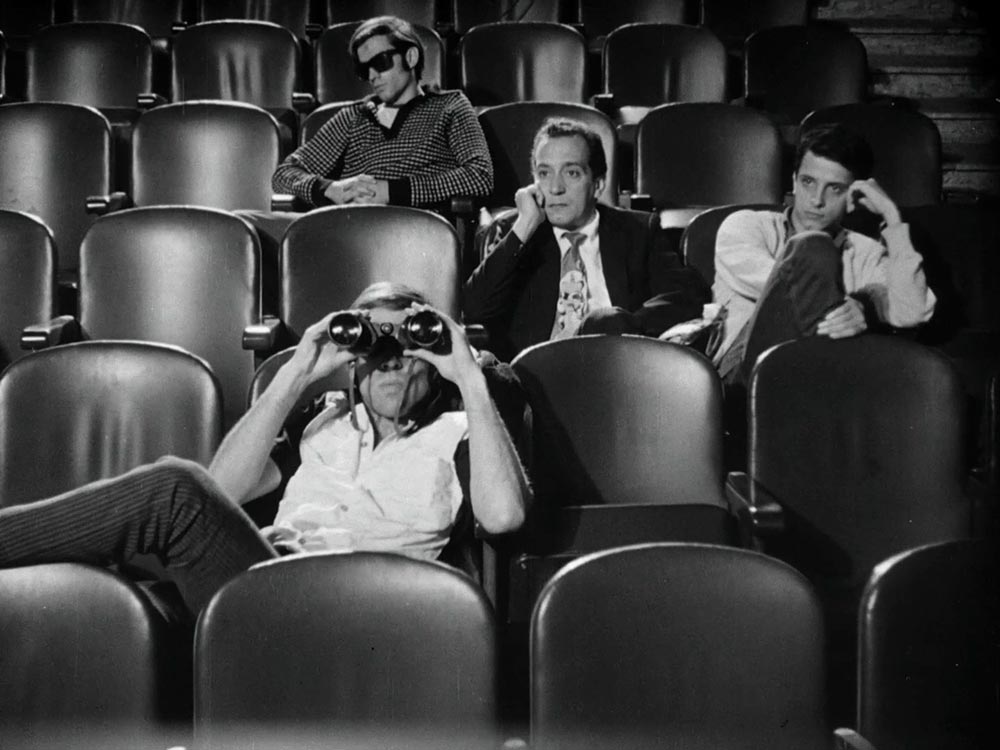The film critic and programmer Ruarí McCann recently remarked that rewatching Rogério Sganzerla’s The Red Light Bandit (1968) made him think of “what John Berger said about gravitating more and more to art that is destructive, in rejection of a tyrannical world.” Sganzerla’s madcap riff on the real-life crime spree carried out by João Acácio Pereira da Costa was made four years into the U.S.-backed military dictatorship that governed Brazil from 1964 to 1985. The film, a rapid-fire bricolage accompanied by a voice-over in which two sensationalist radio hosts describe the exploits of the titular bandit, is a far cry from the direct political allegories made during the 1960s and ’70s by Brazilian filmmakers affiliated with the nation’s widely influential film movement Cinema Novo. Instead, Sganzerla’s abnegation of plot and compositional unity represent a falling out with aesthetic and narrative coherence under tyranny; his appeal to senselessness reflects the agony and confusion of living in a political war zone.
Sganzerla was the foremost filmmaker associated with Brazilian Marginal Cinema, an underground film movement which originated in the São Paulo slum of Boca do Lixo (whose name translates literally to “Mouth of Garbage”). Although the films associated with the movement deploy various aesthetic strategies, their cynicism about their nation’s political trajectory, and their use of the same actors and settings, unites them. The Red Light Bandit represents a talisman for the movement. The film’s unique blend of B-movie schlock with political theory inaugurated a new era of experimentation in Brazilian cinema devoted to chasing thrills and testing the limits of what was permissible. As the bandit in Sganzerla’s film, Paulo Villaça dons several faces and costumes to match the film’s relentless genre-hopping. Sganzerla has declared that his film “is a western about the Third World,” but added, “that is to say, a fusion and blending of various genres . . . a western, but also a musical, a documentary, a cop film, a comedy (or is it slapstick?), and science fiction.”
His invocation of the western can be understood as an appeal to myth-making and the role that genre has played in reifying First World fantasies on the silver screen. In the Cold War–era classification system, the First World corresponded to the United States and its allies, the Second World to the Communist Bloc, and the Third World to the nonaligned nations where these ideological battles were being played out by proxy. The Third World’s supposed impartiality suggests a place without meaning in terms of the bipolar conflict. Thus, making a western about the Third World meant laying the foundations for a new cinematic imaginary beyond the horizon of hegemonic film traditions. The Red Light Bandit exists in this peripheral zone, and its mockery of dominant cinema’s storytelling techniques, aesthetic strategies, and acceptable behaviors is a gesture of demolition. With this gesture, it became possible to pave the way for a new cinematic language that had rid itself of all previous influences.
The Red Light Bandit screens tonight, December 15, at Hunter College’s Leubsdorf Gallery as part of the series “Udigrudi Fridays.”



